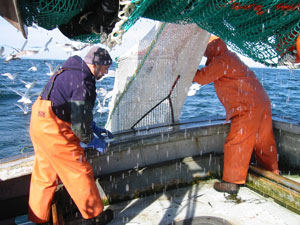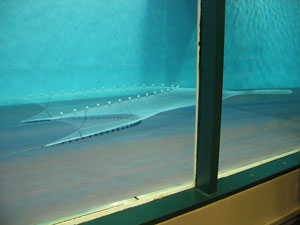Gearing up for Shrimp Season:
“Topless” Shrimp Nets Increase Catch, Decrease Bycatch
by Ken LaValley and Becky Zeiber
 Dave Goethal, left, and deck hand Paul Kuncho hauling back one of the new topless shrimp trawls off New Hampshire. Goethal participated in the collaborative research project that led to the development of this gear. At the stern is the escape vent, bounded by dark rope, in the net extension, with a nordmore grate that filters out by catch behind it. Photo courest of Pingguo He, UNH Research Scientist
Dave Goethal, left, and deck hand Paul Kuncho hauling back one of the new topless shrimp trawls off New Hampshire. Goethal participated in the collaborative research project that led to the development of this gear. At the stern is the escape vent, bounded by dark rope, in the net extension, with a nordmore grate that filters out by catch behind it. Photo courest of Pingguo He, UNH Research Scientist |
Northern shrimp season is in full swing, and Community Supported Fisheries, or CSFs in Maine, New Hampshire and Massachusetts are tapping into the market of consumers who want fresh, locally caught shrimp.
An increasing number of fishermen are supplementing their groundfish incomes by shrimping. For those looking to adapt their gear for this fishery, new advances in shrimp trawling nets are proving that sometimes less is more.
It may sound counterintuitive to use a net that is missing almost one-third of its mesh, but new “topless” shrimp nets work quite well without the top portion of their netting that usually keeps other fish inside.
Expanded wings are used to increase horizontal spread, explains Pingguo He, a commercial fishing specialist at UNH who helped design the net. David Goethel, a fisherman in Hampton, N.H., collaborated with He on the topless design with very positive results thus far — these gear modifications help improve shrimp catch and decrease finfish bycatch.
The amount of bycatch in the shrimping business has always been a point of concern. Finfish and groundfish accidentally caught sometimes outweighed the shrimp. The Nordmore grid became mandatory in 1992 to help reduce bycatch. Despite being somewhat successful, the grid’s 1” spaced bars still leave room for small fish to pass through and be captured.
The key to finding a better solution to the bycatch problem was to focus on fish swimming behaviors and locations within the water column. Shrimp tend to roll along the bottom of a trawl net, He said, so the top portion of the net could be removed without losing many shrimp. As the net is pulled along, finfish like herring tend to swim over the headline and escape. A similar type of topless trawl to catch flounder and exclude cod has been tested previously by other researchers and fishermen, so the concept is not entirely new.
“The design of this net required a bit of reverse engineering,” He explained. “Trawls have evolved to prevent fish from escaping, but in this case, we want the fish to escape.”
Test trials comparing the topless trawl to commercial trawls were conducted using the R/V Ellen Diane, owned and operated by Goethel, in shrimp fishing grounds off New Hampshire. The topless trawl tows yielded almost 13 percent more shrimp and the finfish bycatch — mostly herring — was reduced from 30 percent to 9 percent. Less bycatch means less sorting time needed on the boat, which can also help improve shrimp quality.
During the bitter cold of the northern shrimp season, picking out the shrimp amidst a pile of other fish on a freezing deck with gloved hands can be a very difficult task. Any gear that saves time, labor and perhaps improves worker safety could be a beneficial investment.
 Scale model topless net, 30 feet long, in a tow tank in St. Johns, Newfoundland. The basic strategy in developing gear is to use scale models to study performance. Photo courest of Pingguo He, UNH Research Scientist
Scale model topless net, 30 feet long, in a tow tank in St. Johns, Newfoundland. The basic strategy in developing gear is to use scale models to study performance. Photo courest of Pingguo He, UNH Research Scientist |
The engine power needed to tow the topless trawl is similar to what is required for a standard commercial shrimp trawl, allowing it to be used by the smaller inshore otter trawl fleet without modifications.
He, who also designed the dual-grate size selecting grid currently in use by 20 fishermen, believes that there will not be one single gear design for the shrimp fishery that will work in every situation.
“What we try to do as gear researchers is to give the industry additional tools,” He explained.
“During the later part of the season or in specific habitats where shrimp size classes are mixed, the dual-grid system would be appropriate. On the other hand, when fishing in an area with an abundance of herring, the topless shrimp trawl or other bycatch reduction system may be the gear of choice.”
Gear modifications can be time-consuming, costly, and downright tricky to do correctly.
Fishermen interested in buying a new topless shrimp net or altering their existing trawl may soon have a way to test the technology before investing in it. He and Ken La Valley, a commercial fisheries specialist with N.H. Sea Grant, have secured funds from the National Marine Fisheries Service to make several topless trawls for demonstration purposes. Their hope is to allow shrimp fishermen to test the gear before making the decision to buy or alter a net.
“Seeing is believing,” said La Valley. “Our experience with the dual-grid system over the past several years has been that word of mouth is priceless. As fishermen begin using the gear and having positive results, their neighbors want to learn more about the gear configuration and how they can use it. The topless shrimp trawl might go that same route and end up being quite popular.”
“I think this net has great potential for local shrimp fishermen,” He added.
|





